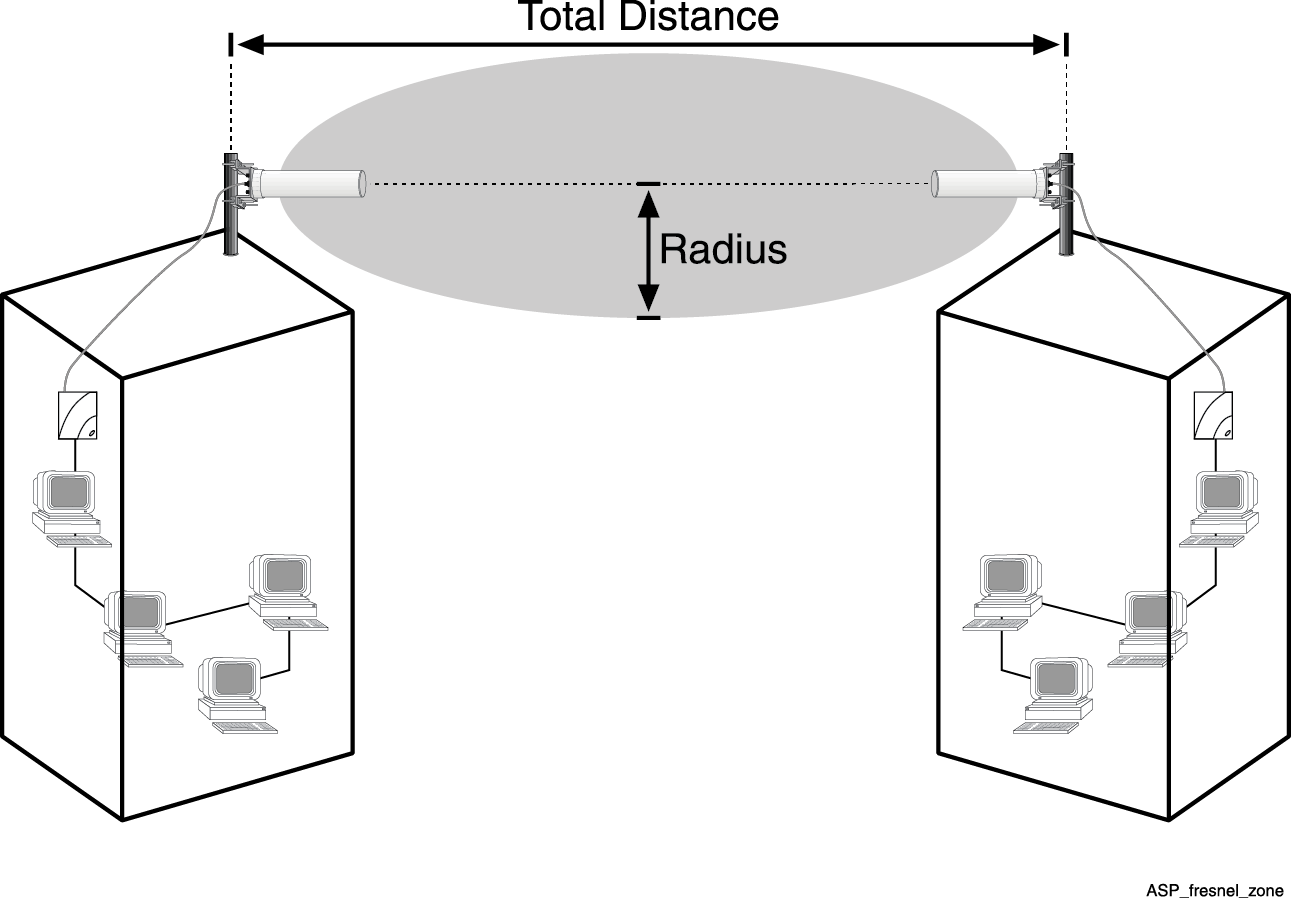Antenna Location Criteria
- Type of antennas
- Length of cable connecting the antenna to the access point
- Data rate required
- In a LAN-to-LAN network, the distance between the buildings
- Obstructions in the signal path
- In a wireless infrastructure network, the area around the antenna where clients need to communicate with the access point
Line of sight
The shape of the radio beam, defined as the Fresnel zone, is widest in the middle. The Fresnel zone is shown as the gray area between the antennas in Fresnel zone and line of sight clearance. The exact shape and width of the Fresnel zone is determined by the distance between the antenna and frequency of the radio signal.
The radius of the radio beam, shown as the lower half of the Fresnel zone, is the distance from the center of the beam outward in any direction. The length of the radius is not based on the data rate and the type of antenna.

The radius can be calculated using the following formula:

Where
D = distance between the antennas in kilometers (km)
f = frequency in GHz
60% of the Fresnel zone must be clear of obstructions to be line of sight. In addition to the Fresnel zone height requirement, earth curvature may become a factor in paths longer than 2 km. The additional antenna height can be calculated using the following formula:

Where
D = distance between the antennas in kilometers
H = height required to overcome earth curvature
| Distance between Tx and Rx antennas (km) | Fresnel zone radius (m) | Earth curvature (m) | Minimum antenna height requirements (m) |
|---|---|---|---|
| 2 | 7.9 | 0.08 | 7.98 |
| 5 | 12.5 | 0.49 | 12.99 |
| 10 | 17.67 | 1.94 | 19.61 |
| 15 | 21.64 | 4.37 | 26.01 |
| 20 | 25 | 7.77 | 32.77 |
| 25 | 28 | 12.14 | 40.14 |
| 30 | 30.6 | 17.48 | 48.08 |
| Distance between Tx and Rx antennas (km) | Fresnel zone radius (m) | Earth curvature (m) | Minimum antenna height requirements (m) |
|---|---|---|---|
| 2 | 5.22 | 0.08 | 5.3 |
| 5 | 8.24 | 0.49 | 8.73 |
| 10 | 11.67 | 1.94 | 13.61 |
| 15 | 14.3 | 4.37 | 18.67 |
| 20 | 16.5 | 7.77 | 24.27 |
| 25 | 18.46 | 12.14 | 30.6 |
| 30 | 20.22 | 17.48 | 37.7 |
For optimal performance, ensure that the antenna products you choose, in combination with the height of the antenna installation above ground, provide sufficient clearance to allow your antenna installation to cover the distance between the two sites.
Additional antenna location requirements
- Lightning protection
A lightning rod must be placed close to the antenna mast or wall bracket. This is required to protect the antenna from direct lightning strikes.
- Grounding System
A grounding system is required when installing an outdoor antenna with an indoor or outdoor access point.
Direct earth grounding of the antenna and the lightning protector is necessary to protect the antenna from lightning and the build-up of static electricity. The access point and the lightning protector must be connected to the same earth ground using separate grounds. The antenna and the mounting structure require separate grounds to the same earth ground, using an equipotential bonding conductor. Check with a certified antenna installer, or local electrician, to make sure the antenna is properly grounded.
Note
Ensure that the cable between the antenna and lightning protector is at least 3.0 ft (0.9 m) away from high-voltage or high-current cable.

